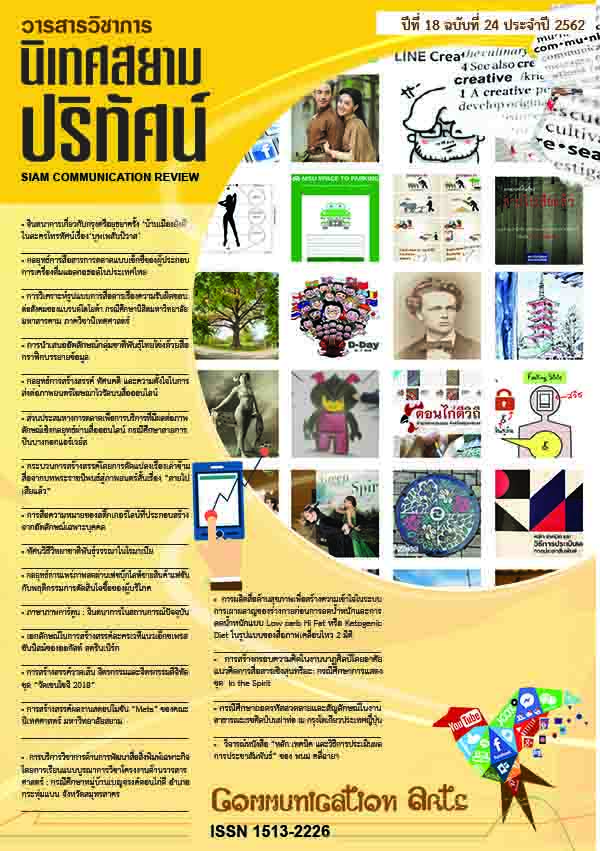การวิเคราะห์รูปแบบการสื่อสารเรื่องความรับผิดชอบต่อสังคมของโตโยต้า: กรณีศึกษานิสิตมหาวิทยาลัยมหาสารคาม ภาควิชานิเทศศาสตร์
Main Article Content
บทคัดย่อ
โตโยต้าเป็นแบรนด์รถยนต์ที่มีมูลค่าอันดับหนึ่งของโลก และมียอดจำหน่ายสูงสุดในไทย ซึ่งอุปกรณ์ในการขับขี่นับเป็นสาเหตุหนึ่งต่อการเกิดอุบัติเหตุบนท้องถนน ดังนั้นโตโยต้าจึงเป็นองค์กรที่มีรูปแบบการสื่อสารความรับผิดชอบต่อสังคม Corporate social responsibility: CSR) อย่างมีแบบแผน การวิจัยเชิงเปรียบเทียบกรณีศึกษาครั้งนี้จึงมีวัตถุประสงค์เพื่อศึกษารูปแบบ CSR ของโตโยต้า ผ่านการจัดโครงการ Campus challenge 2016 โดยโตโยต้าถนนสีขาวกับนิสิตมหาวิทยาลัยมหาสารคาม ผู้ผ่านเข้ารอบสุดท้ายของโครงการจำนวน 3 กลุ่ม โดยการวิเคราะห์เอกสาร และการสัมภาษณ์กลุ่มร่วมกับการสังเกต ผลพบว่า โตโยต้ามีแนวคิดหลักคือ “โตโยต้าขับเคลื่อนความสุข” แทรกอยู่ในทุกขั้นตอนการดำเนินธุรกิจ ส่วนนิสิตมีความภาคภูมิใจที่ได้ร่วมกิจกรรมกับโตโยต้า แต่ไม่ส่งผลต่อแนวโน้มการตัดสินใจซื้อแบรนด์นี้ในอนาคต ส่วนผลการดำเนินงานของนิสิตเพื่อรณรงค์การขับขี่ปลอดภัยภายในมหาวิทยาลัยมหาสารคามนั้นมีความคิดสร้างสรรค์ทั้ง 3 ทีม แต่ไม่สามารถปรับเปลี่ยนพฤติกรรมการใช้รถใช้ถนนที่ผิดกฎจราจรในระยะยาวได้ ส่วนทีมที่มีแนวโน้มความยั่งยืนของการดำเนินงานมากที่สุดคือ การทำโฮมเพจค้นหาที่จอดรถ เนื่องจากเป็นการแก้ปัญหาโดยตอบรับกับพฤติกรรมนิสิตนักศึกษาที่ใช้เทคโนโลยีเป็นส่วนหนึ่งในการดำเนินชีวิต
Article Details
เอกสารอ้างอิง
ปาริชาต สถาปิตานนท์ และพิชญ์ณัฐ เนื่องจำนงค์. (2559). การสื่อสารเรื่องความรับผิดชอบต่อสังคมขององค์กรธุรกิจ: จากแนวคิดสู่ปฏิบัติการและเส้นทางวิจัยที่ท้าทายในอนาคต. วารสารการประชาสัมพันธ์และการโฆษณา, 9(1), 73-92.
พิพัฒน์ นนทนาธรณ์. (2553). การจัดการความรับผิดชอบต่อสังคมขององค์กร: การสร้างข้อได้เปรียบในการแข่งขันอย่างยั่งยืน. นนทบุรี: บริษัทธิงค์ บียอนด์ บุ๊คส์.
ภาษาอังกฤษ
Carroll, A. B. (1991). The pyramid of corporate social responsibility: toward the moral management of organizational stakeholders. Business horizons, 34(4), 39-48.
Ferrell, O. C., Thorne, D. M., & Ferrell, L. (2010). Social responsibility and business (4th ed.). Canada: Cengage Learning.
Gruber, V., Kaliauer, M., & Schlegelmilch, B. B. (2017). Improving the effectiveness and credibility social responsibility messaging: An Austrian model identifies influential CSR content and communication channels. Journal of Advertising Research, 57(4), 397-409.
Hildebrand, D., Demotta, Y., Sen, S., & Valenzuela, A. (2017). Consumer responses to corporate social responsibility (CSR) contribution type. Journal of consumer research, 44, 738-758.
Kraisornsuthasinee, S., & Swierczek, F.W (2006). Interpretations of CSR in Thai companies. JCC. 22, 53-65.
ออนไลน์
กระทรวงเทคโนโลยีสารสนเทศและการสื่อสาร, สำนักงานสถิติแห่งชาติ. (2559). สถิติคดีอุบัติเหตุการจราจรทางบก จำแนกตามสาเหตุการเกิดอุบัติเหตุจากบุคคล สาเหตุจากสิ่งแวดล้อม และ สาเหตุจากอุปกรณ์ที่ใช้ขับขี่ทั่วราชอาณาจักร พ.ศ.2549-2558, กรุงเทพมหานคร. เข้าถึงได้จาก http://service.nso.go.th/nso/web/statseries/statseries21.html
บริษัท โตโยต้า มอเตอร์ ประเทศไทย จำกัด. (2560). Environmental report 2017. เข้าถึงได้จาก https://www.toyota.co.th/csr/report/pdf/Sustainability_Report_2017.pdf
เหตุ! คนไทยตายจากอุบัติเหตุอันดับ1เอเชีย-อันดับ 2 ของโลก. (2560). เข้าถึงได้จาก http://www.bangkokbiznews.com/news/detail/785684 2560


